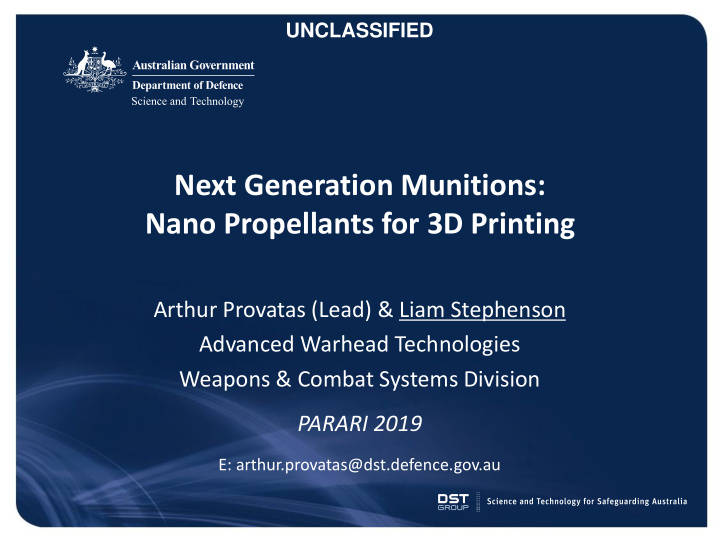



UNCLASSIFIED Next Generation Munitions: Nano Propellants for 3D Printing Arthur Provatas (Lead) & Liam Stephenson Advanced Warhead Technologies Weapons & Combat Systems Division PARARI 2019 E: arthur.provatas@dst.defence.gov.au
UNCLASSIFIED Introduction DST plays a key role in positioning the ADF to fully exploit capabilities afforded by emerging weapons concepts Transformative Energetics Transformative Energetics Enabling advanced weapons systems that offer disruptive Enabling advanced weapons systems that offer disruptive performance gains and increasing the agility, safety and performance gains and increasing the agility, safety and efficiency of munitions manufacture. efficiency of munitions manufacture.
UNCLASSIFIED Transformative Energetics Lines of Effort Advanced Materials • Nano-technology Processing Technology • Resonant Acoustic Mixing 3D Printing of Energetics Next Generation Munitions
UNCLASSIFIED Nano-Energetics Material properties change significantly at nano-scale (<0.1 m m) – Higher surface area – Increased chemical reactivity Burn Rate – Enhanced mechanical properties Performance Processing – Higher solubility Nano Energetics pathways – Improved heat dissipation – Smaller void sizes Safety Traditional Materials – Reduction in defects Sensitivity Enhanced performance and safety
UNCLASSIFIED Spray Drying - Evaporative Crystallisation Top-Down Process - Binder Encapsulated - Simple and Scalable - Best Polymorph Not Bead Milling Nano Processes Always Retained - Comminution Process - Utilises Ceramic Beads (<500 nm) Bottom-Up - Single Polymorph - Scalable
UNCLASSIFIED 3D Printing of Propelling Charges Performance Benefits Tuneable geometry and integrated charge design – Greater range 22% m.v – Enhanced muzzle velocity increase – Increased precision – Charge Uniformity – Longer weapon life Production Benefits Manufacturing agility (on-demand production) Reduced manufacturing footprint
UNCLASSIFIED Digital Light Processing 3D Printing Methods Vat Photopolymerisation Liquid photopolymer in a vat Material Jetting is selectively cured by light- Droplets of build material are activated polymerisation selectively deposited Binder Jetting Liquid bonding agent is UV Paste selectively deposited to join Material Extrusion powder materials Material is selectively dispensed through a nozzle Sheet Lamination or orifice Sheets of material are bonded to form an object Powder Bed Fusion Thermal energy selectively fuses regions of a powder Directed Energy bed Deposition Focused thermal energy is used to fuse materials by melting as they are being deposited High Energy Images from Hybrid Manufacturing Technologies
UNCLASSIFIED Energetic Feedstock Challenges High solids loading (> 60 vol. %) Compositional homogeneity Compatibility with printing method Curability (UV Photopolymers) Physicochemical stability
UNCLASSIFIED Work Program The development of nano-propellant material suitable for use as 3DP feedstock Initial studies focused on formulations of RDX and cellulose acetate butyrate (CAB) capable of producing spherical sub-micron particles Sensitiveness and mechanical testing revealed that these particles were slightly more insensitive and mechanically superior to that of micron-sized RDX Transitioned to propellant relevant formulations with different polymer binders Current focus on spray drying experiments 250 Normalisd Values (%) 200 150 RDX Bulk 100 n(RDX/CAB) 50 0 Max Load Modulus Yield Stress
UNCLASSIFIED Spray Drying: Büchi 290 closed loop system EM + Binder Rapid Co-precipitation Atomisation Dissolved in Yields Nanocomposite Of Solution Organic Solvent Granules Heating Coil Aspirator Process Variables Solution Feed Rate Atomizing Gas Rate Drying Temperature Nozzle Solvent Type Concentration of Solute Drying Cyclone Outlet Product Chamber Separator Filter
UNCLASSIFIED RDX Type 1 Class 1, d 50 200 m m Spray dried nRDX Type 1 Class 1
UNCLASSIFIED Nano Propellant Formulations RDX Class 1 Comparison Cases nRDX Class 1 n(RDX/NC) Propellant Formulations n(RDX/NC/P1) RDX: Cyclotrimethylenetrinitramine NC: Nitrocellulose P1: Polymer 1
UNCLASSIFIED Morphological Characteristics Increasing Crystal Size Qiu et al, Powder Tech., 2015, 274, 333-337
UNCLASSIFIED Spray Dried RDX/NC RDX / NC*_Ethyl Centralite *NC stabilised with ethyl centralite (EC)
UNCLASSIFIED Spray Dried RDX/NC/Polymer 1 RDX / NC / P1
UNCLASSIFIED Mechanical Sensitiveness Testing nRDX n(RDX/NC) n(RDX/NC/ RDX Type 1 P1) Class 1 Rotter Impact 90 80 90 80 BAM Friction (N) 168 240 360 96 Static Discharge (J) 4.5 4.5 4.5 4.5 Temp. Ignition ( o C) 206 205 215 219 Compared with Class 1 RDX, nRDX variants are: • Significantly less sensitive to friction; • Exhibit lower ignition temperature; • Other parameters are comparable
UNCLASSIFIED Burn Testing
UNCLASSIFIED Burn Times Formulation Time RDX, normal (bulk) > 1 min nRDX 13 s n(RDX_NC) 10 s n(RDX_NC_P1) 7 s (residue)
UNCLASSIFIED X-Ray Diffraction Analysis RDX can exist as several polymorphs ( α , β , γ …) – The α polymorph is stable at STP for bulk-form RDX Nano-RDX-NC-P1 α -RDX Nano-RDX RDX
UNCLASSIFIED XRD Analysis RDX during spray drying , 2011, ARDEC Kumar et al, Propellants Explos. Pyrotech ., 2014, 39: 383-389
UNCLASSIFIED Future Testing Scale up 3D printing Burn rate testing Optimisation New formulations Other Avenues of Nano-Energetic Production Bead milling
UNCLASSIFIED Next Generation Munitions: Nano Propellants for 3D Printing Arthur Provatas (Lead) & Liam Stephenson Advanced Warhead Technologies PARARI 2019 E: arthur.provatas@dst.defence.gov.au
Recommend
More recommend